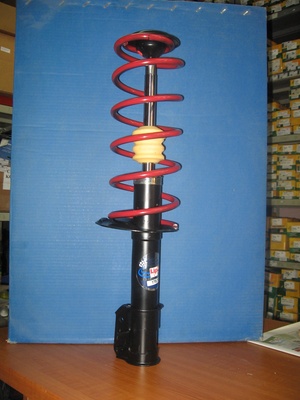
A smooth ride in your vehicle depends on many factors that work in concert with each other. The struts, also called McPherson struts, are one of the suspension's most important parts. The struts control the ride of the vehicle more than any other by absorbing sudden shocks, maintaining a constant vehicle height and keeping the tires flat on the pavement. Without the struts, the rest of the suspension parts would suffer from jolts and vibrations radiating up through the axles to the frame. Worn or failing struts have telltale symptoms that an observant vehicle owner can detect.
Take the vehicle on a test drive. Find an area that has an irregular surface, like a parking lot that has speed bumps. Drive over the speed bumps at or below 5 mph and pay attention to the reaction of the vehicle's suspension. Harsh jolts or clanking noises will indicate that the struts (shocks) have lost their cushioning effect, which causes them to "bottom out", collapsing enough to allow the frame to make metal-to-metal contact.
Note how well the ease of the steering wheel returns after you have made several sharp turns in a confined area. Watch for vehicle sway or leaning when making turns. Worn struts will allow excessive leaning. Apply the brakes suddenly a few times and look for the hood to dip sharply. If upon sudden acceleration, the hood raises up sharply, this indicates worn struts.
Park the vehicle and place the shift selector in park or neutral with the emergency brake set. Perform a rebound test by stepping up onto the front bumper, and using your weight, bounce the vehicle up and down (you can do this with the rear bumper too). After bouncing several times, step off the bumper and watch the front end. The front end should not continue rebounding more than one or two times. Worn shock struts and springs will allow multiple rebounds.
Inspect the condition of the front tire tread. Any cups or scalping in the rubber indicates the struts have worn to the point where they can no longer keep the tires firmly planted on the road's surface. Tires with cupping or scalping will appear as though a knife was used to carve out small sections of rubber--a definite indication the struts have failed. Check the rear tires, too. The rear tires might have been on the front axle at one time and rotated to the rear.
Use the floor jack to lift the vehicle up high enough to place it on jack stands--two at the rear and two at the front. Slide under the vehicle with a shop light. Examine the shock cartridges inside the springs. Look for any signs of oil running down the shock body, or a dirty, oily film on the lower half of the shock body. Such signs indicate the shock cartridge seals have broken and have lost their hydraulic fluid. Such shocks have lost all of their dampening strength and must be replaced.
Look for any broken or loose mounting bolts and the top and bottom of the strut.
Make certain all four tires have the same pressure. Take a tape measure and extend it from the top of the fender wheel well to the ground's surface and record the inches. Measure all four fender wheel wells. Note that the front and rear measurement will deviate naturally because of the vehicle's design, but the side to side measurement should not deviate more than 1/2 inch. Struts that have unequal measurements have lost their ride height.